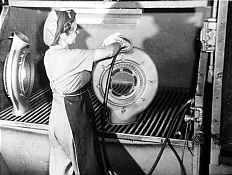 |
 |
 |
 |
News-Sentinel file photo
|
|
Rosie the Riveter
A Fort Wayne woman, one of thousands of women nationwide who became "Rosie the Riveter" when they took factory jobs making components for the war effort, works on one of the superchargers that General Electric produced for military aircraft.
|
|
|